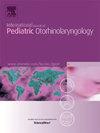Outcomes of stretching exercises after lingual frenotomy in infants: A prospective, interventional study
IF 1.2
4区 医学
Q3 OTORHINOLARYNGOLOGY
International journal of pediatric otorhinolaryngology
Pub Date : 2025-02-21
DOI:10.1016/j.ijporl.2025.112280
引用次数: 0
Abstract
Objective
To evaluate the safety and efficacy of stretching exercises after frenotomy for ankyloglossia.
Study design
Prospective cohort study.
Setting
Single academic tertiary care hospital.
Methods
Subjects with ankyloglossia were enrolled from 4/5/2021–4/5/2023. All patients underwent in-office frenotomy using scissors. Patients enrolled from 4/5/2021–10/5/2021 and 4/6/2022–4/5/2023 were assigned to the stretching group; those enrolled from 10/6/2021–4/5/2022 were assigned to the non-stretching group. Caregivers of patients in the stretching group were instructed on how to perform stretching exercises. All patients returned to clinic after one month for evaluation. Chart review was performed and demographic and outcomes data were collected.
Results
Eighty-eight patients were included. There were 25 patients in the non-stretching group and 63 in the stretching group; however, only 36 were adherent to stretching exercises and 27 were non-adherent. The average age of participants was 50.0 ± 45.5 days; 59.0 % were male. Preoperatively, all but one patient had breastfeeding difficulties. For the stretching adherent, stretching non-adherent, and non-stretching groups, there were persistent feeding difficulties present in 0 % (n = 0), 14.8 % (n = 4), and 16 % (n = 4), respectively (p = 0.024). Recurrent ankyloglossia was present in 5.6 % (n = 2), 40.7 % (n = 11), and 16 % (n = 4) of patients in the stretching adherent, stretching non-adherent, and non-stretching groups, respectively (p = 0.003). A revision procedure was required in 5.6 % (n = 2), 37.0 % (n = 10), and 32 % (n = 8) of those in the stretching adherent, stretching non-adherent, and non-stretching groups, respectively (0.005).
Conclusion
Stretching exercises improved patient-reported feeding difficulties, the development of recurrent frenulum, scarring, and need for revision procedure. Postoperative regimen adherence may be challenging for caregivers.
一项前瞻性、介入性研究:婴儿舌骨切开术后伸展运动的结果
目的评价骨切开术后拉伸运动治疗强直性咬合的安全性和有效性。研究设计前瞻性队列研究。单一的三级专科医院。方法于2021年4月5日至2023年4月5日招募强直性咬合患者。所有患者均行剪骨切开术。在2021年4月5日至2021年10月5日和2022年4月6日至2023年4月5日期间入组的患者被分配到拉伸组;在2021年6月10日至2022年4月5日期间入学的学生被分配到非拉伸组。拉伸组患者的护理人员被指导如何进行拉伸运动。所有患者于1个月后返回诊所进行评估。进行图表回顾,收集人口统计和结局数据。结果共纳入88例患者。非拉伸组25例,拉伸组63例;然而,只有36人坚持做伸展运动,27人不坚持。参与者的平均年龄为50.0±45.5天;59.0%为男性。术前,除1例患者外,其余患者均存在母乳喂养困难。拉伸粘附组、拉伸非粘附组和非拉伸组持续进食困难的比例分别为0% (n = 0)、14.8% (n = 4)和16% (n = 4) (p = 0.024)。在拉伸粘附组、拉伸非粘附组和非拉伸组中,复发性强直性咬合分别为5.6% (n = 2)、40.7% (n = 11)和16% (n = 4) (p = 0.003)。在拉伸粘附组、拉伸非粘附组和非拉伸组中,分别有5.6% (n = 2)、37.0% (n = 10)和32% (n = 8)的患者需要进行翻修手术(0.005)。结论伸展运动改善了患者报告的进食困难、复发系带的发展、瘢痕形成和需要翻修手术。术后治疗方案的依从性对护理人员来说可能具有挑战性。
本文章由计算机程序翻译,如有差异,请以英文原文为准。
求助全文
约1分钟内获得全文
求助全文
来源期刊
CiteScore
3.20
自引率
6.70%
发文量
276
审稿时长
62 days
期刊介绍:
The purpose of the International Journal of Pediatric Otorhinolaryngology is to concentrate and disseminate information concerning prevention, cure and care of otorhinolaryngological disorders in infants and children due to developmental, degenerative, infectious, neoplastic, traumatic, social, psychiatric and economic causes. The Journal provides a medium for clinical and basic contributions in all of the areas of pediatric otorhinolaryngology. This includes medical and surgical otology, bronchoesophagology, laryngology, rhinology, diseases of the head and neck, and disorders of communication, including voice, speech and language disorders.

 求助内容:
求助内容: 应助结果提醒方式:
应助结果提醒方式:


